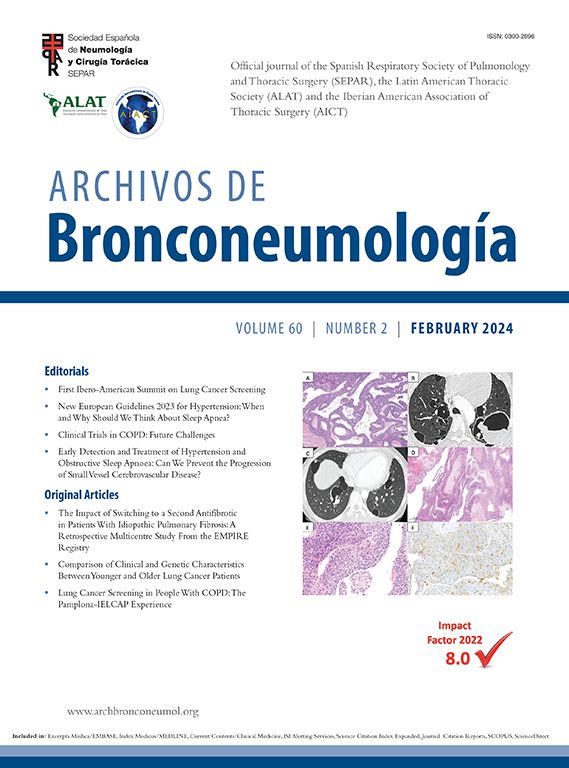支气管镜诊断肺泡-胸膜瘘的算法。
IF 8.7
3区 医学
Q1 RESPIRATORY SYSTEM
引用次数: 0
摘要
肺泡-胸膜瘘(APF)是一种临床实体,是诊断和治疗方面的难题:这项工作的目的是设计一种诊断算法,用于对不适合手术治疗的患者进行肺泡-胸膜瘘的解剖学检测:方法:对47名患者进行前瞻性非随机研究。诊断程序包括:(a) 支气管镜检查前:计算机轴向断层扫描(CT)和植入电子胸膜引流系统(EPD);(b) 内窥镜检查:气囊支气管内闭塞(EO)、选择性支气管内氧气灌注(OI)(2 升)和选择性支气管造影(BS)(通过连续透视灌注碘化放射对比剂):结果:样本主要为男性(81%)。诊断方法显示:(a) 15/46 例患者(占样本的 31.9%)通过 CT 确定了 APF 的解剖位置,使用 EPD 确定了漏气模式的变化(间歇性或持续性漏气)以及用药镇静剂后的定量;(b) 内窥镜:使用 EO、OI 和 BS,分别有 57.1%、81% 和 63.4%的患者通过内窥镜确定了 APF 的解剖位置。结合这些诊断测试,我们确定了 91.5%样本中 APF 的解剖位置。85.1%的病例未出现并发症:结论:通过软支气管镜诊断 APF 是一种有用的方法,具有足够的安全性和有效性。建议的诊断算法包括使用 EPD 和进行 CT 扫描。关于内镜诊断:如果是持续性漏气,首选 OE;如果是间歇性漏气,我们建议采用支气管内 OI,辅以 BS(敏感性分别为 81% 对 63.4%,并发症分别为 8.1% 对 7.3%)。本文章由计算机程序翻译,如有差异,请以英文原文为准。

Algorithm for the Bronchoscopic Diagnosis of Alveolar-Pleural Fistula
Alveolar-pleural fistulas (APF) are a clinical entity that represents a diagnostic and therapeutic challenge.
Objective
The objective of this work is to design a diagnostic algorithm for the anatomical detection of APF in patients who are not candidates for surgical treatment.
Method
Prospective non-randomized study of 47 patients. Diagnostic procedures were performed: (a) prior to bronchoscopy: computed axial tomography (CT) and implantation of electronic pleural drainage system (EPD) and (b) endoscopic: endobronchial occlusion (EO) by balloon, selective endobronchial oxygen insufflation (OI) (2 l) and selective bronchography (BS) (instillation of iodinated radiological contrast using continuous fluoroscopy).
Results
The sample was predominantly male (81%). The diagnostic methods revealed: (a) Determination of the anatomical location of APF by CT in 15/46 patients (31.9% of sample), and variations in the pattern (intermittent or continuous air leak) and quantification after drug administration sedatives using EPD, (b) endoscopic: anatomical determination of APF was achieved in 57.1, 81 and 63.4% respectively using EO, OI and BS. The combination of the diagnostic tests allowed us to determine the anatomical location of the APF in 91.5% of the sample. No complications were recorded in 85.1% of cases.
Conclusions
The diagnosis of APF by flexible bronchoscopy is a useful method, with an adequate safety and efficacy profile. The proposed diagnostic algorithm includes the use of EPD and performing a CT scan. Regarding endoscopic diagnosis: in case of continuous air leak, the first option is OE; and if the leak is intermittent, we recommend endobronchial OI, with BS as a secondary option (respective sensitivity 81% vs 63.4% and complications 8.1% vs 7.3%).
求助全文
通过发布文献求助,成功后即可免费获取论文全文。
去求助
来源期刊

Archivos De Bronconeumologia
Medicine-Pulmonary and Respiratory Medicine
CiteScore
3.50
自引率
17.50%
发文量
330
审稿时长
14 days
期刊介绍:
Archivos de Bronconeumologia is a scientific journal that specializes in publishing prospective original research articles focusing on various aspects of respiratory diseases, including epidemiology, pathophysiology, clinical practice, surgery, and basic investigation. Additionally, the journal features other types of articles such as reviews, editorials, special articles of interest to the society and editorial board, scientific letters, letters to the editor, and clinical images. Published monthly, the journal comprises 12 regular issues along with occasional supplements containing articles from different sections.
All manuscripts submitted to the journal undergo rigorous evaluation by the editors and are subjected to expert peer review. The editorial team, led by the Editor and/or an Associate Editor, manages the peer-review process. Archivos de Bronconeumologia is published monthly in English, facilitating broad dissemination of the latest research findings in the field.
 求助内容:
求助内容: 应助结果提醒方式:
应助结果提醒方式:


